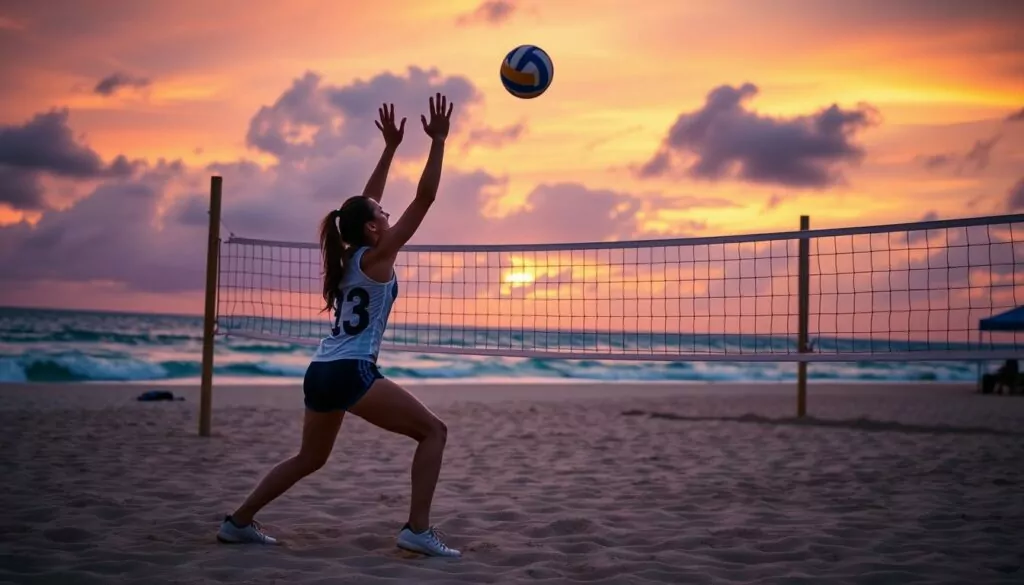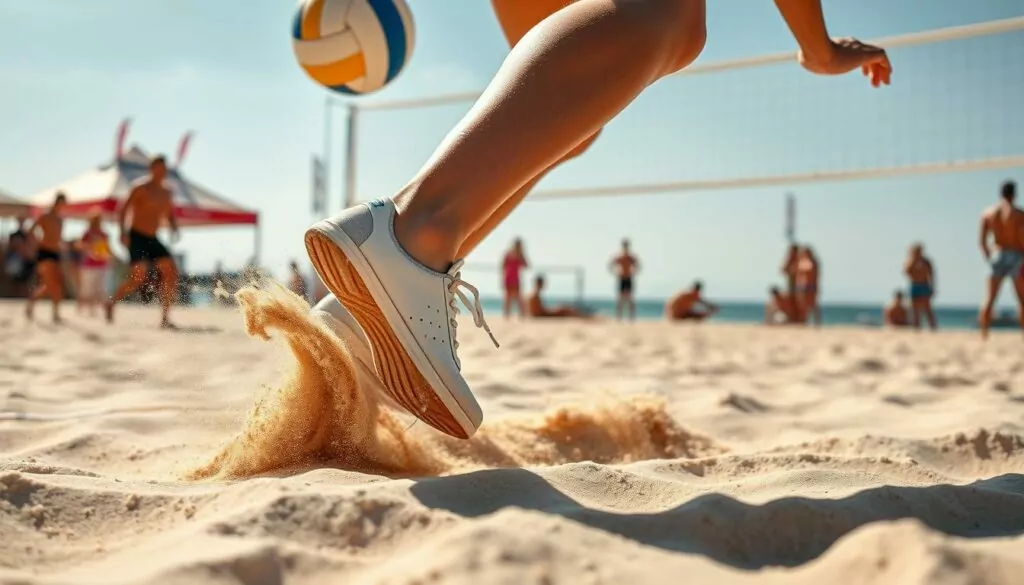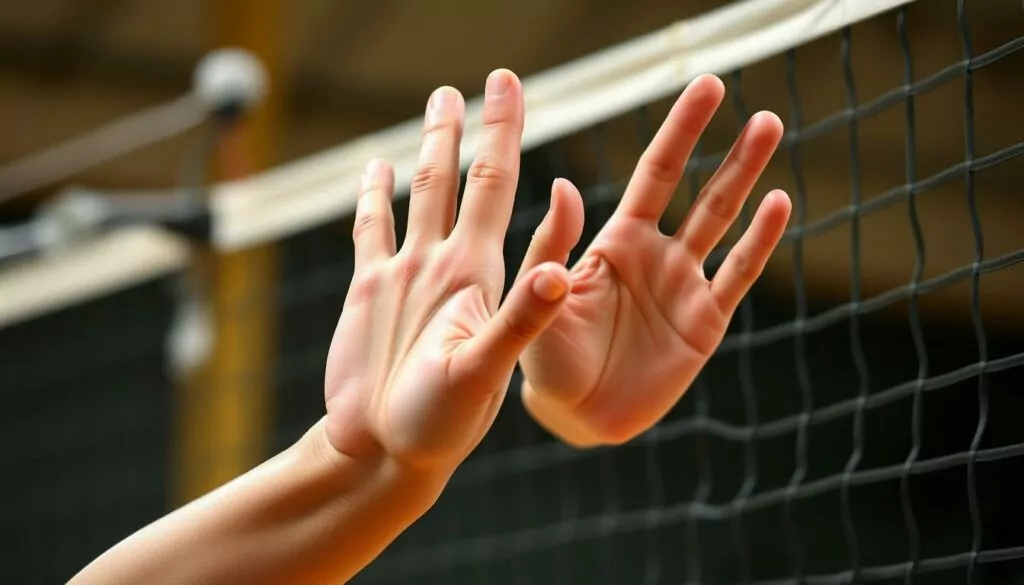I’ll not forget the day that I realized the real potential that blocking can bring to volleyball. In a tight game I smashed down the powerful spike by executing an incredibly timed leap. The crowd cheered and adrenaline rushed through my body.
This guide outlines essential blocking strategies and techniques. You’ll discover how to become an effective blocker and raise the game you play to greater levels.
Key Takeaways
- Create an effective blocking position and position to provide optimal defensive coverage
- Learn to discern the hitter’s strategy and apply effective hand position
- Increase the efficiency of your Blocking footwork to increase your timing and jump performance
- Team up with your teammates to implement sophisticated blocking strategies.
- Find and correct block mistakes that are common to enhance your overall performance
Understanding the Fundamentals of Volleyball Blocking Skills

Mastering blocking fundamentals is key to a strong defensive game. Let’s explore the essential aspects of volleyball blocking skills. We’ll start with the basic stance and positioning.
Basic Blocking Stance and Position
The blocking stance is your defensive foundation. Stand with feet shoulder-width apart and knees slightly bent. Keep your back straight and shoulders square.
Distribute your weight evenly and keep your head up. This allows you to read hitters effectively. Extend your arms overhead with palms facing the net.
The Role of a Blocker in Defense
A blocker’s main job is to disrupt the opposing team’s attack. Anticipate the hitter’s movements and time your jump correctly. This can slow down or redirect the ball.
Effective blocking disrupts the opponent’s offense. It also boosts your team’s defensive confidence and momentum.
Common Blocking Mistakes to Avoid
As you develop your blocking skills, watch out for these common pitfalls:
- Jumping too early or too late, failing to time the block properly
- Losing focus and not reading the hitter’s approach and shot selection
- Overcommitting to one side of the net, leaving the other side vulnerable
- Poor hand and wrist positioning, resulting in an ineffective block
Address these mistakes to refine your blocking stance. This will improve your volleyball blocking skills. You’ll become a better reader of hitters on the court.
Mastering Blocking Footwork Patterns

Perfecting your blocking footwork is crucial for volleyball success. Blocking footwork helps maintain balance and quick reactions at the net. Let’s explore footwork techniques, jump reach improvement, and timing tips for blockers.
Footwork forms the basis of effective blocking. A quick first step is vital for proper positioning and jump timing. Master the blocking shuffle by sliding sideways in a low, balanced stance.
Improving your jump reach is key to blocking success. Plyometric exercises can boost your vertical leap significantly. Focus on leg power, core engagement, and arm drive for better jumps.
Perfecting your timing as a blocker is crucial. Read the hitter’s cues and anticipate the set. Be ready to jump at the right moment for successful blocks.
| Footwork Drill | Focus | Benefits |
|---|---|---|
| Lateral Shuffle Drill | Lateral movement, balance, and reaction time | Develops quick, decisive first steps to get into blocking position |
| Approach Jump Drill | Vertical leap and timing | Improves jump reach and ability to time the block with the hitter’s attack |
| Reaction Drill | Anticipation and split-second decision making | Enhances the blocker’s ability to read the hitter’s cues and react accordingly |
Mastering blocking footwork, jump reach, and timing will make you a formidable blocker. You’ll shut down attacks and lead your team to victory with these skills.
Perfect Hand Positioning and Reach Techniques

Mastering blocking is vital for volleyball defense. Key elements include hand positioning and reach techniques. Proper hand formation, penetration, and wrist positioning can boost your blocking skills significantly.
Proper Hand Formation Above the Net
For effective blocking, maintain a solid hand formation above the net. Keep hands shoulder-width apart with spread fingers. Face your palms towards the opposing team’s hitters.
This position helps you read the ball’s path quickly. It also allows for fast reactions to opponent attacks.
Penetration and Press Techniques
Blocking success relies on penetration and press techniques. Push your hands through the net to return the ball. Use your jump reach to maximize coverage when pressing the ball.
Wrist and Finger Positioning
Wrist and finger placement greatly impacts blocking ability. Keep wrists firm and fingers spread for quick reactions. Avoid bending wrists back to maintain power and control.
Proper positioning enhances power and precision in your hand positioning during blocks. This technique is crucial for effective defense.
Perfecting hand positioning and reach techniques is crucial for volleyball blocking. Focus on these elements to improve your defensive game. Your skills will contribute significantly to your team’s success.
Advanced Team Blocking Strategies
Blocking is a team effort in volleyball. Advanced strategies can greatly impact the game. Let’s explore double and triple block coordination and communication systems.
Double Block Coordination
Double blocking requires precise timing and teamwork. Blockers must read the hitter’s approach and position themselves effectively. By moving together, they can stop powerful opposing hitters.
Regular drills help teams develop chemistry for this strategy. Practice improves instincts and execution, making double blocks more effective.
Triple Block Execution
Triple blocks are a formidable defensive tactic. They demand excellent footwork, communication, and quick decision-making from three players. Each blocker must understand their specific role and responsibilities.
Reacting in harmony to the hitter’s movements is crucial. Mastering this technique gives teams an edge in important matches.
Communication Systems
Clear communication is vital for elite blocking. Develop concise verbal and non-verbal cues for your team. This helps players anticipate movements and adapt to changing situations.
Invest time in perfecting your team’s communication. The result will be dominant net play and frustrating blocks for opponents.
